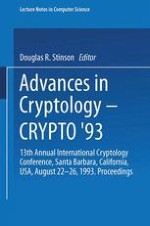The CRYPTO ’93 conference was sponsored by the International Association for Cryptologic Research (IACR) and Bell-Northern Research (a subsidiary of Northern Telecom), in co-operation with the IEEE Computer Society Technical Committee. It took place at the University of California, Santa Barbara, from August 22-26, 1993. This was the thirteenth annual CRYPTO conference, all of which have been held at UCSB. The conference was very enjoyable and ran very of the General Chair, Paul Van Oorschot. smoothly, largely due to the efforts It was a pleasure working with Paul throughout the months leading up to the conference. There were 136 submitted papers which were considered by the Program Committee. Of these, 38 were selected for presentation at the conference. There was also one invited talk at the conference, presented by Miles Smid, the title of which was “A Status Report On the Federal Government Key Escrow System.” The conference also included the customary Rump Session, which was presided over by Whit Diffie in his usual inimitable fashion. Thanks again to Whit for organizing and running the Rump session. This year, the Rump Session included an interesting and lively panel discussion on issues pertaining to key escrowing. Those taking part were W. Diffie, J. Gilmore, S. Goldwasser, M. Hellman, A. Herzberg, S. Micali, R. Rueppel, G. Simmons and D. Weitzner.
